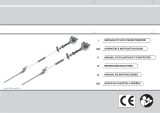
33
GB
prevent corrosion.
· Store the machine and its accessories in a cool, dry
place where it is not accessible by children, well
clear of unprotected heat sources and corrosive
substances such as garden chemical products.
Before using the machine after a prolonged period
of disuse check all the seals and the carburettor;
we recommend having this procedure carried out
by an Authorized Service Centre.
CAUTION – Store the machine in a place
where it is protected from direct sunlight
entering through windows to avoid damage of
any of its plastic parts. Do not use leftover
mixture that is more than one month old,
otherwise the engine may be seriously damaged
and the warranty will be invalidated.
11. ENVIRONMENTAL PROTECTION
Environmental protection should be a priority of
considerable importance when using the
machine, for the benefit of both social cohesion
and the environment in which we live.
- Try not to cause any disturbance to the
surrounding area.
- Scrupulously comply with local regulations and
provisions for the disposal of waste materials
after mowing.
- Scrupulously comply with local regulations and
provisions for the disposal of oils, petrol,
batteries, filters, deteriorated parts or any
elements which have a strong impact on the
environment. This waste must not be disposed
of as normal waste, it must be separated and
taken to specified waste disposal centres
where the material will be recycled.
Demolition and disposal
When the machine reaches the end of its service
life, do not dispose of it into the environment;
instead take it to a waste disposal centre.
Most materials used in the manufacture of the
machine are recyclable; all metals (steel,
aluminium, brass) can be delivered to a normal
recycling station. For information contact your
local waste recycling service. Waste disposal must
be carried out with respect for the environment,
avoiding soil, air and water pollution.
In all cases, applicable local legislation must
be complied with.
When the machine is scrapped also the CE mark
label must be destroyed together with this
manual.
CAUTION – If the muffler is damaged, it
must be replaced. If the muffler frequently
becomes blocked, this could be an indication that
the efficiency of the catalytic converter is limited.
WARNING – Do not operate your machine
if the muffler is damaged, missing or
modified. Operating the machine with an
improperly maintained muffler will increase
the risk of fire and hearing loss.
EXTRA MAINTANANCE ADVISABLE
It is advisable to inspect the machine by a
specialized technician at an authorized service
network at the end of season, if used intensively,
and every two years if with normal use.
ATTENTION: All maintenance operations
not reported in this manual must be carried
out by an authorized Service Center. To ensure
steady and regular mist blower operation,
remember that parts must only be replaced with
ORIGINAL SPARES.
Any unauthorized changes and/or use of non-
original replacement parts may result in serious
injury or death to the operator or third parties.
9. TRANSPORTATION
Only transport the mist blower with the engine
switched off.
WARNING -
When transporting the machine on
a vehicle, ensure that it is rmly and securely fastened
using straps or belts. The machine must be transported
in the vertical position with an empty tank, also
ensuring compliance with applicable transport
regulations for such machines.
Place the throwing pipe in vertical position;
fasten it to one of the shoulder strap by using the
hook (A, Fig.18A) present on the clamp of the tap
on the throwing pipe.
10. STORAGE
If the machine is to be stored for long periods:
· Drain the fuel from the tank.
· Start the engine and run it at low speed until it
runs out of fuel and stops.
· Clean the tank thoroughly.
· Clean the machine thoroughly and remove
any debris and dirt (encrusted dust, grass, etc.).
· Smear a thin lm of oil on all metal parts to






















